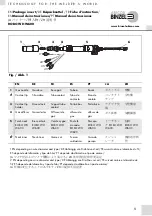
14
• The
TAWI
VacuEasylift lifters are made for use under a roof protected from wind and rain.
• The lighting in the place of installation must be adequate, during installation and operation.
• The overhead crane system/jib crane must be approved for the rated maximum lifting capacity of
the vacuum lifter.
• During design and installation of the suspending system, it is vital to take into account relevant
standards and regulations, the load bearing capacity of the ceiling and floor structure and the
attachment devices and the relevant basic design information of the suspending system. For
information on suspension (jib crane, crane system etc) see separate manual.
• The overhead crane system must be installed by qualified technicians and all safety and main-
tenance instructions must be followed.
• Re-tighten all bolts within 1-2 months of installation.
• This vacuum lifter may not be used before the test in Appendix I has been carried out and signed.
• Do not start/test the vacuum pump before installation is complete and the suction foot is >10 cm
from ground!
• Any modifications to the product must be carried out by qualified TAWI technicians.
• A mandatory dynamic operational test must be executed before the vacuum lifter may be put
into operation.
• Motion limiters may not be used to limit the horisontal motion of the vacuum lifter. The installa-
tion of a motion limiter may cause serious damage to the vacuum lifter. It may also cause involun-
tary disengagement of parts resulting in parts falling down and the risk of serious body injuries.
• Note the colour code system for safe assembly of lift unit to suction foot /accessory. ONLY
PARTS WITH MATCHING COLOUR CODE MARKING MAY BE ASSEMBLED! Incorrect combina-
tions of lift unit and accessory may cause very serious injuries.
Verify installation
When the installation of the vacuum lifter is carried out, and before the vacuum lifter is put into
operation, it must be submitted to a dynamic operational test at the place of installation. The dynamic
operational test must be carried out by qualified technicians with a load of 1.1 times the maximum load
specified by the manufacturer.
This test shall be carried out for each motion of the vacuum lifter, testing its full function, with repeated
starts and stops throughout the complete working range.
This test shall be considered successful if the vacuum lifter has been found to perform all its functions
and if the examination subsequent to the test reveals no damage to mechanisms or structural
components, and no connection has been loosened or been damaged.








































